
Source: Chainalysis; Compilation: Deng Tong, Bitchain Vision
East Asia is the world’s sixth largest cryptocurrency economy this year, accounting for 8.9% of global value between July 2023 and June 2024.The region received over $400 billion in on-chain value over the same period.
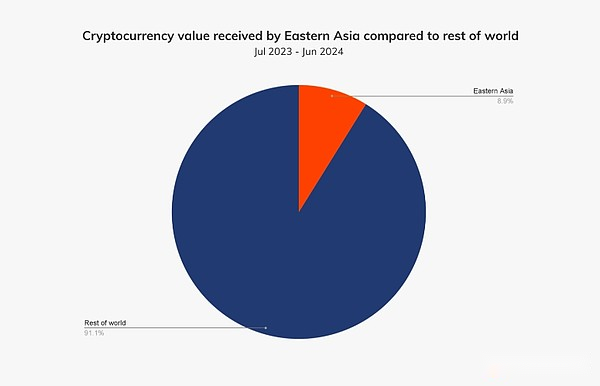
During the study period, the share of cryptocurrency transaction value in East Asia remained relatively stable with no significant fluctuations.
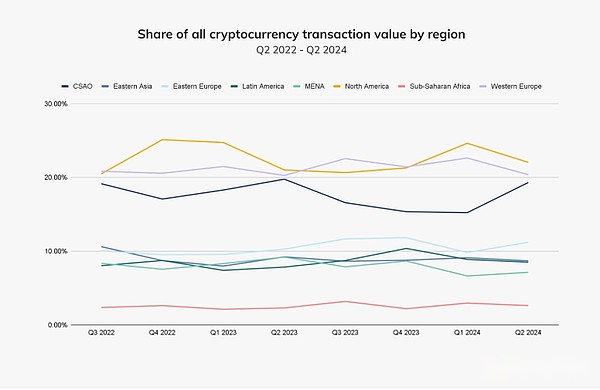
Similar to all other regions in this report,Centralized exchanges are the most popular service category in East Asia, accounting for 64.7% of the value of cryptocurrencies.
During the study period, the share of cryptocurrency transaction value in East Asia remained relatively stable with no significant fluctuations.

Similar to all other regions in this report,
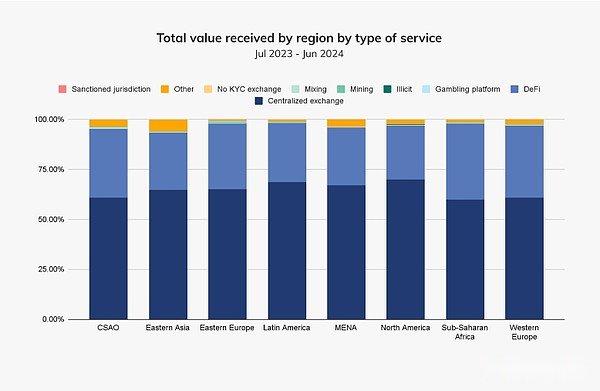
Most of these activities are driven by large transfers from institutions and professional investors.It is worth noting that East Asia accounts for the largest share of professional-scale transfers compared to any other region studied in this report.
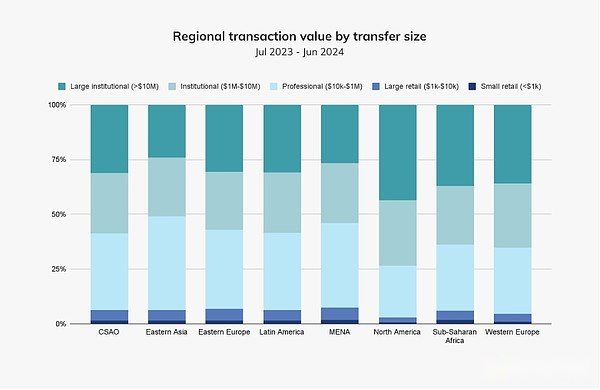
The services used by professional investors are in sharp contrast with the services used by institutional investors.As shown below, professional investors mainly use centralized exchanges (CEX), while institutional investors use decentralized exchanges (DEX) and other decentralized services (DeFi).We speculate that institutional investors often seek investment strategies that take advantage of market inefficiency; DEX usually offers more arbitrage opportunities than CEX due to its wide coverage of assets.
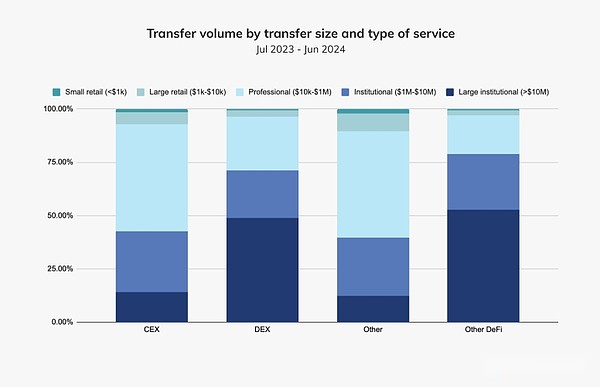
East Asia accounts for five of the 50 regions with the highest cryptocurrency adoption in the world: South Korea (19), China (20), Japan (23), Hong Kong (29) and Taiwan (40).Below, we will explore in detail what drives cryptocurrency adoption in these countries.
South Korea remains the largest market in East Asia
During the study period,South Korea receives cryptocurrencies worth approximately US$130 billion, leading the way in East Asia.

South Korea’s share of transaction volume in East Asia has also been growing steadily since the first quarter of 2023.We interviewed the head of a top cryptocurrency exchange in South Korea, who speculated that several factors contributed to this growth:“Distrust of traditional financial systems has led investors to seek cryptocurrencies as alternative assets.The public perception of cryptocurrency as a viable investment option has been further consolidated as large companies such as Samsung and large enterprises in the region seeking to improve operational transparency and efficiency.”

A head of another Korean exchange gave us more insights on these trends: “As a top IT country, South Korea can easily trade digital assets through mobile apps and PCs. The general public’s growing interest in cryptocurrencies, especially after Bitcoin broke $70,000 in January 2024. “This rise in trading activity is evident in many places — more specifically altcoins and stablecoins.Altcoins are the currency that Koreans use primarily to trade with the Korean won (KRW), and the altcoins have the highest outflow on global exchanges compared to any other crypto assets.The figure below shows that the increase in stablecoin outflows from December 2023 coincides with the time when USDT went public on major Korean exchanges such as Coinone and Bithumb.
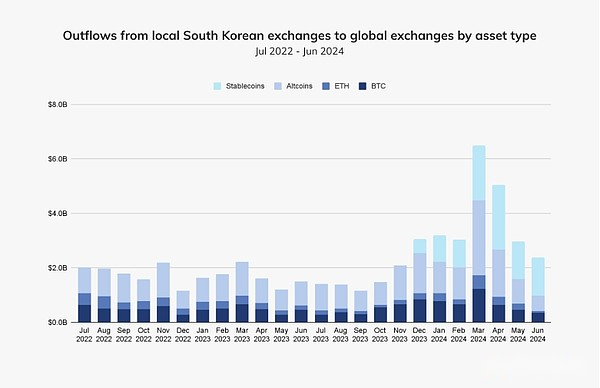
After altcoins, Bitcoin (BTC) is the second largest cryptocurrency with trading volume, as famous as the Korean won.
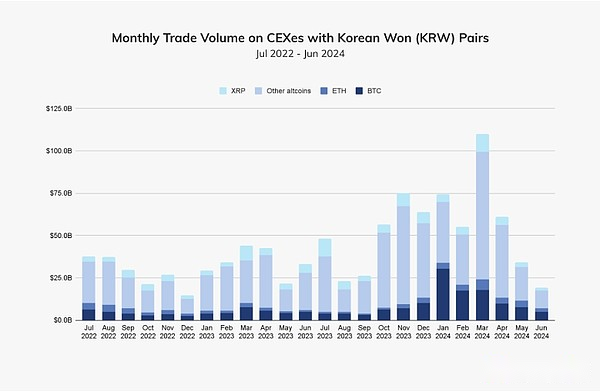
“Ripple has been very popular in South Korea since 2017, when it was expected that it would replace the SWIFT International Remittance System,”The head of the second exchange pointed out that he refers to the international information system used for international payments and settlements.“The reason we think this popularity is that Ripple transfers are very fast, about two seconds, and it has a relatively low unit price compared to BTC and ETH.”
In terms of actual trading strategies, Koreans seem to frequently use local exchanges to transfer funds into and to global exchanges that provide diversified assets, arbitrage opportunities, margins and exit channels.The amount of funds transferred from these local exchanges to global exchanges is highly correlated with the South Korean premium index, indicating that there is an arbitrage opportunity.
The person in charge of the first exchange explained:“Kimchi premium refers to the phenomenon that cryptocurrency prices in the Korean market are higher than those in the global market. This is mainly because the demand in South Korea is higher than that in the global market. The kimchi premium will fluctuate according to market conditions and regulatory changes, which makes it a traderPopular phenomena.”It is worth noting that in March 2024, when Bitcoin hit an all-time high, the premium of kimchi soared.

The above-mentioned strong interest in altcoins and diversified trading opportunities for affixed South Korea’s bright prospects as a regional leader in cryptocurrency innovation.As we will explore later, this interest, along with the supportive regulatory framework in other regions, may further accelerate the prominent position of cryptocurrencies in East Asia.
Hong Kong may ultimately affect China’s reopening of cryptocurrency markets
As we have discussed in previous years, China’s relationship with cryptocurrencies has been turbulent, characterized by repeated crackdowns and regulatory changes.Although the Chinese government is an early center for cryptocurrency mining and trading, the Chinese government has imposed increasingly stringent restrictions on unauthorized cryptocurrency activities out of concerns about financial stability, fraud and capital flight.These actions have led to extensive restrictions on crypto-related business activities in 2021 and undoubtedly led to a decline in overall crypto-related network traffic visits from transaction-related services from China starting from mid-2020.
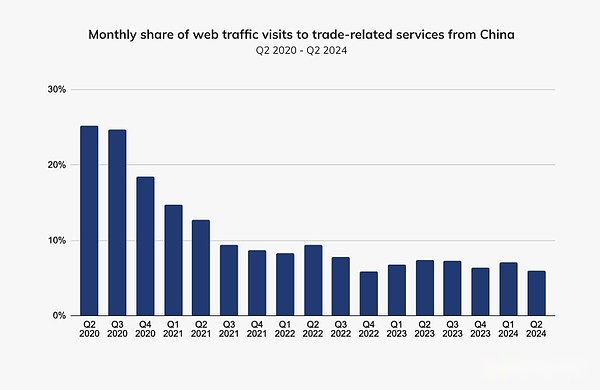
In any case, Hong Kong has become the cryptocurrency hub in Greater China, and the regulatory authorities’ openness to cryptocurrencies and the decisiveness of developing regulatory frameworks have further promoted institutional adoption.Hong Kong is not an independent country, but a special administrative region of China with a unique legal and regulatory framework.Its unique position allows it to promote financial innovation more flexibly, which is why we treat it separately from mainland China in this report.
Not surprisingly, Hong Kong has the highest year-on-year growth rate in East Asia, reaching 85.6%, ranking 30th in the world in our global cryptocurrency adoption index.

Below, let’s take a look at some of the latest trends in mainland China and Hong Kong.
User’s eyes turn
After the Chinese government shut down access to mainstream cryptocurrency exchanges in 2021, users began to turn their attention elsewhere.
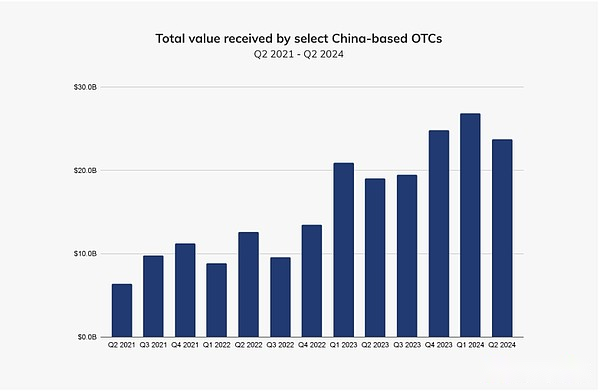
The same pattern applies when we look at the relationship between the inflow of capital in cryptocurrencies over-the-counter trading and the decline of the Shanghai Composite Index, which measures stock trading on the Shanghai Stock Exchange, as well.

Hong Kong’s supportive regulatory framework drives institutional adoption
In June 2023, Hong Kong securities regulators implemented a new regulatory regime for the Virtual Asset Trading Platform (VATP).The system provides retail investors with a regulated access to cryptocurrencies, but also sets strict prudence, consumer protection and anti-money laundering/anti-terrorist financing standards.Over the past year, regulators in Hong Kong have been working hard to implement this new regime.
May 31, 2024 marks the end of the transition period of this new regime, meaning that the exchange can only operate in Hong Kong if it is licensed or “deemed” to be licensed.Local branches of several popular exchanges withdrew their permit applications by May 31 and therefore had to stop providing trading services to Hong Kong residents.Given that they have traded hundreds of millions of dollars since 2022, these developments could trigger a shift to licensed or “deemed” exchanges, or reduce activity overall.As we see below, the share of value obtained by these exchanges has been steadily declining, with recent activity hovering around 10% to 15%.
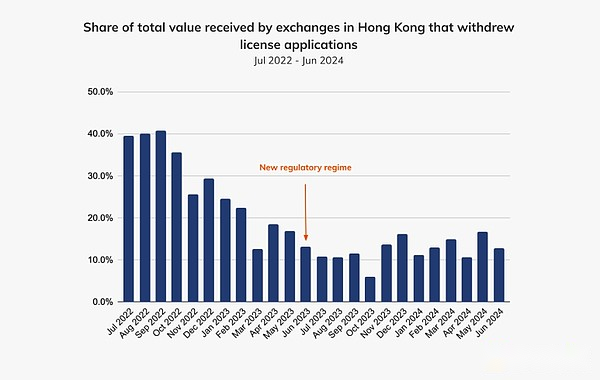
Stablecoins account for more than 40% of Hong Kong’s total quarterly value; this proportion may grow as the Hong Kong Monetary Authority (HKMA) regulatory framework takes effect, as regulated stablecoins will be allowed to be sold to retail investors in Hong Kong.

On April 30, 2024, the Securities and Futures Commission (SFC), a financial regulator in Hong Kong, approved the start of public trading of three Bitcoins and three Ethereum-based spot Bitcoin ETFs.A month before this launch, we saw a significant increase in institutional bitcoin transfers, many of which occur on mainstream exchanges that work with institutional-oriented businesses.
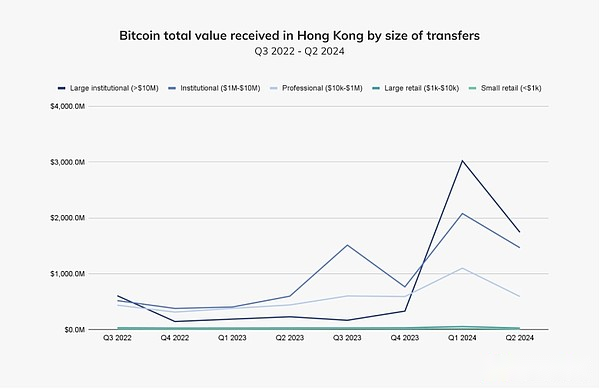
OSL is a leading Hong Kong digital asset trading platform that provides institutional-level cryptocurrency trading services, and its CEO Kevin Cui explains how these ETFs affect the market.“As market conditions improve, we see signs of growing institutional interest, which may lead to an increase in capital inflows in the near future. These ETFs not only provide a regulated avenue for investing in digital assets, but also inspire peopleInterest in direct holdings of BTC and ETH. This shift is significant because it marks a shift from traditional financial instruments to more direct participation in digital assets, reflecting a broader acceptance and understanding of its potential by the institutional investment community.”








